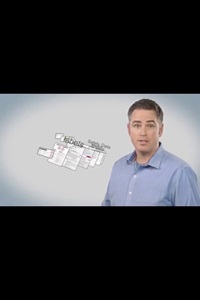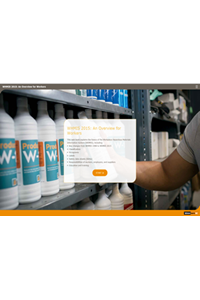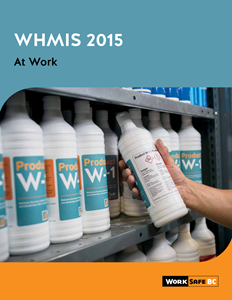WHMIS 2015
WHMIS was updated in 2015 to align with the Globally Harmonized System of Classification and Labelling of Chemicals (GHS) developed by the United Nations. The updated classifications, labels, and safety data sheets improve communication, clarity, and worker safety. Although the system changed, the responsibilities of workers, employers, and suppliers did not.
- Labels
- Safety data sheets
- Resources
Hazardous products can cause injuries or diseases in workers. The goal of WHMIS is to provide workers with the information they need to stay safe on the job. With WHMIS, hazardous products must have a label and a safety data sheet (SDS). Labels identify the product's hazards and precautionary measures. Safety data sheets, which must be available on the work site, provide more detailed information.
If the product is not a hazardous product by definition, the employer may still have to provide training, supervision, and safe work procedures.
What changed with WHMIS 2015
WHMIS 2015 aligned the hazards classification and communication requirements with those used in the U.S. and by other major trading partners. The key changes from WHMIS 1988 to WHMIS 2015 are:
- More comprehensive hazard classification criteria
- New hazard classes
- Physical hazard criteria now consistent with the Transportation of Dangerous Goods (TDG) Regulations
- Standardized language
- New requirements for supplier labels
- New standardized 16-section safety data sheet (SDS) format
Hazard classes and categories
WHMIS 2015 divides hazardous products into two major hazard groups: physical hazards and health hazards. These two groups are further divided into hazard classes, which group together products with similar properties.
| Physical hazard class | Description |
|
Flammable gases Flammable aerosols Flammable liquids Flammable solids |
These products have the ability to ignite (catch fire). The main hazards are fire or explosion. |
|
Oxidizing gases Oxidizing liquids Oxidizing solids |
These products may cause or intensify a fire, or cause a fire or explosion. |
| Gases under pressure |
Includes compressed gases, liquefied gases, dissolved gases, and refrigerated gases. Compressed gas, liquefied gas, and dissolved gas cylinders or containers may explode if heated. Refrigerated liquefied gases are very cold and can cause severe cold (cryogenic) burns or injury. |
| Self-reactive substances and mixtures | These products may react on their own to cause a fire or explosion, or may cause a fire or explosion if heated. |
|
Pyrophoric liquids Pyrophoric solids |
These products can catch fire very quickly (spontaneously) if exposed to air. |
| Self-heating substances and mixtures | These products may catch fire if exposed to air. Unlike pyrophoric products, they will only ignite after a longer period of time or when in large amounts. |
| Substances and mixtures which, in contact with water, emit flammable gases | In some cases, the flammable gas may ignite very quickly (spontaneously). |
| Organic peroxides | These products are unstable, highly reactive, or explosive. They may cause a fire or explosion if heated. |
| Corrosive to metals | These products may be corrosive (chemically damaging or destructive) to metals. |
| Combustible dusts | Finely divided solid particles. If dispersed in air, the particles may catch fire or explode if ignited. |
| Simple asphyxiants | These products are gases that may displace (take the place of) oxygen in air and cause rapid suffocation. |
| Physical hazards not otherwise classified | Any physical hazard not covered in any other physical hazard class. If a product is classified in this class, the hazard on the label and SDS will describe the nature of the hazard. |
Note: Explosives are not included in WHMIS 2015 because they are covered by other legislation.
| Health hazard class | Description |
| Acute toxicity | These products are fatal, toxic, or harmful if inhaled, in contact with skin, or swallowed. |
| Skin corrosion, irritation | These products cause severe skin burns (corrosion) and skin irritation. |
| Serious eye damage/eye irritation | These products cause serious eye damage (corrosion) and eye irritation. |
| Respiratory or skin sensitization | These products may cause allergy or asthma symptoms or breathing difficulties if inhaled. A skin sensitizer is a product that may cause an allergic reaction. |
| Germ cell mutagenicity | These products cause, or are suspected of causing, genetic defects. |
| Carcinogenicity | These products may cause, or are suspected of causing, cancer. |
| Reproductive toxicity |
These products may damage, or are suspected of damaging, fertility or the unborn child. There is an additional category that includes products that may cause harm to breast-fed children. |
| Specific target organ toxicity (single exposure) |
These products cause, or may cause, damage to organs following a single exposure. This class also includes a category for products that cause respiratory irritation, drowsiness, or dizziness. |
| Specific target organ toxicity (repeated exposure) | These products cause, or may cause, damage to organs following prolonged or repeated exposure. |
| Aspiration hazard | These products may be fatal if they are swallowed and enter the airways. |
| Biohazardous infectious materials | These materials are micro-organisms (virus, bacteria, fungi), nucleic acids (DNA, RNA), or proteins that cause or are probable causes of infection, with or without toxicity, in humans or animals. |
| Health hazards not otherwise classified | These products are not included in any other health hazard. If a product is classified in this class, the hazards statement will describe the nature of the hazard. |
Note: Environmental hazards are not required in WHMIS 2015 because they are beyond the scope of Canada's WHMIS legislation. You may still see environmental classes on labels and SDSs produced in other countries as it is permitted to have this information in WHMIS 2015.
Each hazard class contains at least one category, which is assigned a number. Categories may also be called "types," which are assigned an alphabetical letter. In a few cases, subcategories are also specific and identified with a number and a letter.
The category tells you how hazardous a product is:
- Category 1 is always the most hazardous class
- If Category 1 is further divided, Category 1A within the same hazard class will be more hazardous than Category 1B
- Category 2 within the same hazard class is more hazardous than Category 3, and so on
Pictograms
Pictograms are graphic images that, at a glance, depict the hazard(s) associated with a specific product. Pictograms are assigned to specific hazard classes or categories. Some lower-risk hazardous products meet the criteria for hazard classes but do not require a pictogram.
The pictograms, as shown below, will be on the supplier labels and the SDS of the hazardous product.
| Pictogram | Name and description |
.ashx) |
Exploding bomb Explosions or reactivity hazards |
.ashx) |
Flame Fire hazards |
.ashx) |
Flame over circle Oxidizing hazards |
.ashx) |
Gas cylinder Gases under pressure |
.ashx) |
Corrosion Corrosive damage to metals, as well as skin, eyes |
.ashx) |
Skull and crossbones Can cause death or toxicity with short exposure to small amounts |
.ashx) |
Health hazard May cause or suspected of causing serious health effects |
.ashx) |
Exclamation mark May cause less serious health effects or damage to ozone layer |
.ashx) |
Environment* May cause damage to the aquatic environment |
.ashx) |
Biohazardous infectious materials** Organisms or toxins that can cause diseases in people or animals |
* The environmental hazards group was not adopted in WHMIS 2015. Because this hazard group is in the GHS you may see the environmental classes listed on labels and SDSs from other countries.
** The "Biohazardous infectious materials" hazard symbol was included in WHMIS 1988 but is not part of the GHS. This class has been retained in WHMIS 2015 to maintain worker protection.
Labels
Hazardous products used in the workplace must be labelled. Labels alert workers to the major hazards as well as basic precautions or safety steps that should be taken. In most cases suppliers are responsible for labelling hazardous products. Employers need to ensure that all hazardous products are labelled, especially if a hazardous product is transferred from one container to another.
There are two main types of labels: supplier labels and workplace labels.
Supplier labels are provided or attached by the supplier of the hazardous product. Most of the label elements are standardized, and hazard classes and categories have a prescribed signal word, hazard statement(s), pictogram(s), and precautionary statement(s). Supplier labels must be created in English and French.
Suppliers must also meet label requirements for shipping. Depending on how the product is being shipped, the Transportation of Dangerous Goods Act may require additional labels.
Workplace labels are less detailed than supplier labels. A workplace label provides the following information about a hazardous product:
- The product identifier (name)
- Safe handling information
- A reference to the SDS
Workplace labels are required when:
- A hazardous product is made at the workplace and used in that workplace
- A hazardous product is decanted (e.g., transferred or poured) into another container
- A supplier label is lost or cannot be read
Safety data sheets
Every product classified as a hazardous product under WHMIS 2015 that is found in a workplace must have a safety data sheet (SDS). An SDS tells you:
- The product's hazards
- How to use the product safely
- What to expect if the recommendations aren't followed
- How to recognize symptoms of exposure
- What to do if emergencies occur
SDSs are usually written by the manufacturer or supplier of the product. In some circumstances, an employer may be required to prepare an SDS (e.g., when the product is produced and used exclusively in that workplace). WHMIS requires a standard 16-section SDS. All information on the SDS must appear in the specified order.
In British Columbia, SDSs must be checked every three years to ensure they include the most current information.
Confidential business information
Confidential business information (CBI) refers to specific product information that suppliers or employers who are manufacturers are permitted to withhold from an SDS or label for a period of three years. In the U.S., CBI may be called trade secrets or proprietary information. Under WHMIS, a supplier can make a request to Health Canada to protect certain information that gives a company an economic advantage over competitors. Crucial information such as health hazards may never be withheld. If the term "trade secret" or "proprietary information" appears on an SDS, it must have a Hazardous Materials Information Review Act (HMIRA) registration number and date.
The following are examples of statements you may see:
- While a CBI claim is being processed:
CBI under review. HMIRA Registration No.: 1938.
Filing date: July 20, 2016. - After a CBI claim has been granted:
HMIRA Registration No.: 1938. Date granted: August 20, 2016.



